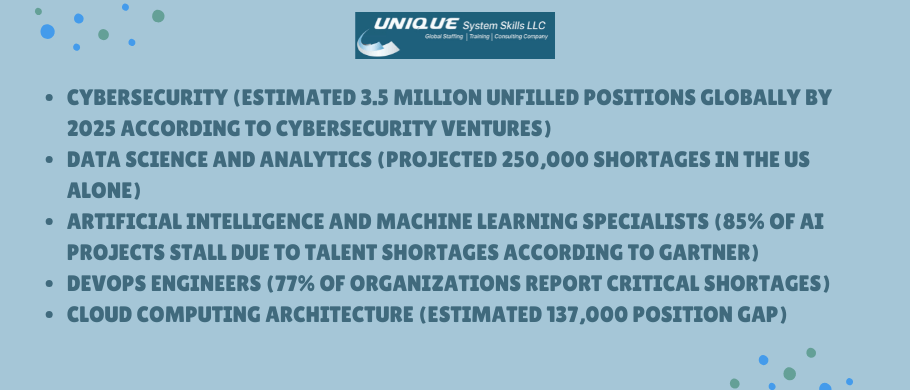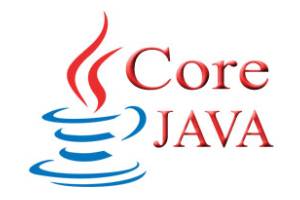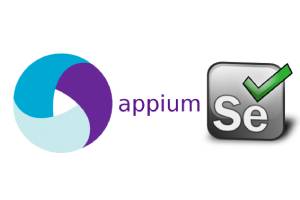
The Current State of the IT Talent Crisis:
Isn’t it wild how fast development and innovation are picking up speed all around the world? But here’s the hitch, the US IT Staffing and IT talent industry is really feeling a crunch with a big talent gap, and it’s getting worse. According to the US Bureau of Labor, computer and technology occupations are expected to expand by approx. 15% between 2021 and 2031.
Which means the world can witness over 6.5 million new job openings coming up soon. The tech sector is on track to grow faster than other industries. In fact, CompTIA reported that there were more than 350,000 open IT positions in the US every quarter of last year!
The reason behind this huge talent gap is that as new tech solutions emerge, they demand new specialized skills. Unfortunately, we’re not keeping up, leading to a staggering 40% gap between the annual demand target and the number of graduates, according to the NCES. Many businesses intend to implement technology within the next five years, referring to the World Economic Forum’s most recent Future of Jobs in 2023 report, indicating a 75% boost by breakthroughs.
Why is there a IT Talent Gap?
Rapid Technological Evolution:
Emerging technologies generate new job categories every 12 to 18 months, according to the McKinsey Global Institute’s 2022 “Technology, Jobs, and the Future of Work” report. There are particularly serious shortages in:

Education and Training Misalignment
A study by the Georgetown University Center on Education and the Workforce found that 65% of computer science programs are at least two years behind industry demands. Graduates with a core understanding but no practical abilities in the latest technologies are the result of this structural imbalance. Additionally, the National Science Foundation stated that just 19% of high schools provide advanced computer science courses, which embed the development of future potential.
Geographic Distribution Challenges
The 2022 “Geography of Innovation” report from the Brookings Institution noted that talent availability was uneven geographically, with only eight metropolitan areas providing 90% of innovation and growth knowledge between 2015 and 2021, which caused difficulty in recruiting and retaining skilled IT workers in rural and secondary markets.
Diversity and Inclusion Shortfalls
Just 26% of computer engineering jobs are held by women, according to the National Center for Women & Information Technology. The Equal Employment Opportunity Commission’s 2022 diversity in tech report shows that minorities are still very neglected and underutilized in available talent pools.
How IT Staffing Agencies Are Transforming Talent Acquisition
Advanced IT Staffing and IT Talent Identification Methodologies
As per IT Staffing Industry Analysts, 2023, Today’s IT staffing agencies use advanced methods to search and screen potential candidates by using predictive analytics techniques, which are 68% more efficient than traditional ways of locating passive applicants. AI aids in matching algorithms that may evaluate over 50 parameters in addition to technical skills along with social listening technologies that keep an eye on developer communities to spot up-and-coming talent, such as Stack Overflow, GitHub, and niche forums. Also keep tracking candidates by relationship intelligence systems even after they have left a particular organization. This helps companies stay ahead of the curve and attract top talent before they hit the job market. When compared to internal hiring procedures, Aberdeen Group found that companies used specialized IT staffing partners, experienced 31% reduction in time-to-hire and a 40% improvement in quality-of-hire metrics.
Comprehensive Skills Validation Systems
IT staffing agencies have crafted meticulous methods aimed at evaluating potential employees. Some of these include performance-based tests that follow a real-life scenario model. Proficiently assessing over a hundred skills and subdomains using a precise skillset matrix, analytical coding by an advanced specialist in the field, and problem-solving and learning style assessments.
According to Deloitte’s 2022 Human Capital Trends study, these validation techniques have been demonstrated to reduce technical skill mismatches by 64% when compared to traditional interview approaches.
Specialized Training and Development Programs
IT staffing companies are being directly addressed by ingenious skills shortfalls and the increasing demand for specialized roles in the tech industry. They conduct pre-deployment boot camps particular to client technology stacks, providing education and placements from professionals with specific learning certifications, which are accelerated initiatives that boost credential completion by 42%. Onboarding and training structures designed to meet each client’s unique needs. “Last-mile” training courses that turn applicants master complementary skills into high-demand positions. Giving mentorship pairing with established industrial leaders to expedite the development of practical knowledge. Career advancement opportunities and ongoing support for continued growth within the diligence.
Over 125,000 individuals from related sectors were effectively transferred into IT professions in 2022 alone by employment agencies with strong training components, according to the World Economic Forum.
Strategic Workforce Planning Partnerships
Above and beyond strategic hiring, top IT staffing firms offer predicted skill requirements 18–36 months ahead of time with a plan of vacancy for important technical positions with the help of analytics for the workforce. Their roadmaps for technology adoption that complement talent recruiting tactics, Benchmarking compensation in specialized and regional markets and identifying experts at risk of flight via retention modeling of possibility.
According to Harvard Business Review research from 2023, companies that had strategic employment alliances were 23% less impacted by talent gaps than competitors that only used internal resources.
Government and Industry Authority Perspectives
Federal Government Initiatives and Findings
The 2023 “Future of Work” project from the U.S. Department of Labor acknowledged IT staffing firms as crucial to workforce development infrastructure. Several effective public-private partnerships were mentioned in the report. Through that study, they mention underserved markets with over 50,000 technologists in the TechHire project, which collaborated with staffing companies.
Placement rates increased by 32% because of the Workforce Innovation and Opportunity Act initiatives that provided funding for specialist IT recruiter training. Around 62% of top IT staffing firms currently employ the standardized frameworks developed by the Commerce Department’s Skills Commons initiative.
For federal agencies having trouble with IT modernization initiatives, the Government Accountability Office’s 2023 study “Managing Technology Workforce Challenges” particularly mentioned working with specialized staffing providers as a suggested approach.
Industry Association Research and Standards
The Staffing Industry Analysts’ 2023 “Statements of IT Recruitment” study pointed out a few critical metrics. 38% of IT recruiters reported that they were having trouble finding qualified candidates for open positions in Fortune 1000 companies. Organizations are using specialized IT hiring partners for greater satisfaction with technical hires. Agency-placed IT professionals had higher retention rates compared to direct hires.
To make a wise decision for selecting a firm of IT recruiters, the Technology Services Industry Association created certification requirements for IT staffing businesses, and verified agencies exhibited 56% better outcomes across placement success indicators.
Key Performance Indicators for IT Staffing
Organizations should assess IT staffing partnerships using comprehensive metrics:
Quantitative measures
When it comes to figuring out how beneficial IT staffing companies are with recruitment, there are a few key points we should look at. First up is time-to-fill, which shows us how quickly and precisely they hire compared to the average time for similar roles out there, while also keeping an eye on how well candidates’ skills match what we need (% required).Time-to-productivity is another important metric; it tells us how fast new hires start making meaningful contributions, judged by how quickly they hit their goals. They also want to track things like project completion rates, meeting deadlines, and innovation output (Think patents, process improvements, and efficiency gains) to get a full picture of how our workforce is performing and the impactful they’re for business.
Qualitative indicators
Qualitative indicators such as employee satisfaction and engagement levels. These parameters are measured by the evaluating team integration, knowledge transfer, cultural contribution, leadership, technical effectiveness, end-user satisfaction, and cross-functional collaboration.
Additionally, they provide valuable insights into the overall health and effectiveness of the organization.
The Future Landscape of IT Staffing
IT staffing companies are still evolving as they react to new trends:
AI-Augmented Recruitment
By 2026, 75% of top IT staffing firms are expected to roll out AI-powered recruiting systems, according to Gartner. These modern systems will do much more than traditional hiring; they’ll help with things like giving a well-rounded view of a candidate’s skills, predicting what skills they’ll develop in the future, matching their personality with how the team works, and spotting unique candidates who have valuable transferable skills. This shift will make hiring a lot more precise and keep the workforce flexible.

Hybrid Workforce Enablement
Deloitte’s Future of Work report suggests that by 2025, 65% of IT departments will be working with hybrid teams, which include full-time staff, contractors, and part-timers. To keep up, smart staffing agencies are rolling out tools for optimizing team makeups, collaboration platforms for remote teams, systems to keep important company knowledge, and performance tools specifically designed for hybrid work. These changes will help improve efficiency, adaptability, and long-term success in IT staffing.
Ongoing Learning Communities
IT staffing firms are creating long-lasting learning communities to help professionals keep pace in this ever-changing field. These efforts include ongoing skill-building programs, quick update seminars during job changes, and niche groups for sharing knowledge. Plus, they’re teaming up with schools to shape the curriculum, making sure the upcoming talent matches what the industry really needs.
Accessing Global Talent
Top organizations are changing the game with international teamwork by tapping into remote work and talent networks in over 50 countries. They’re rolling out follow-the-sun support models to keep services running around the clock while figuring out international employment rules to stay compliant. On top of that, they’re building cultural integration plans to boost teamwork across different cultures, making it easier and smoother to manage a global workforce.
Conclusion
In today’s fast business world, where technology is key to success, finding the right IT talent isn’t just nice to have, it’s essential. Companies that take the initiative to fill the IT talent gap by teaming up with specialized staffing agencies are setting themselves up for long-term growth and innovation. By working alongside IT staffing pros, businesses can tap into niche talent, speed up their digital transformation, simplify their hiring processes, boost their IT capabilities to keep up with changing needs, and create a culture of continuous learning to stay ahead of the competition.
At Unique System Skills WLL, we connect the dots between talent and technology by providing all-in-one IT and non-IT recruiting solutions—both in-person and remote—across the US, India, and GCC. Our services go beyond just staffing, we also help with IT back-office setups and coworking spaces, making it easier for global businesses to grow efficiently. Plus, we offer training and upskilling programs in hot fields like data science, Salesforce, Python, Java, AWS, and more.
As companies dive into digital transformation, those that focus on building strategic workforce partnerships will be the ones that thrive in this ever-changing market.








